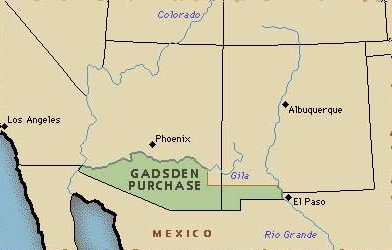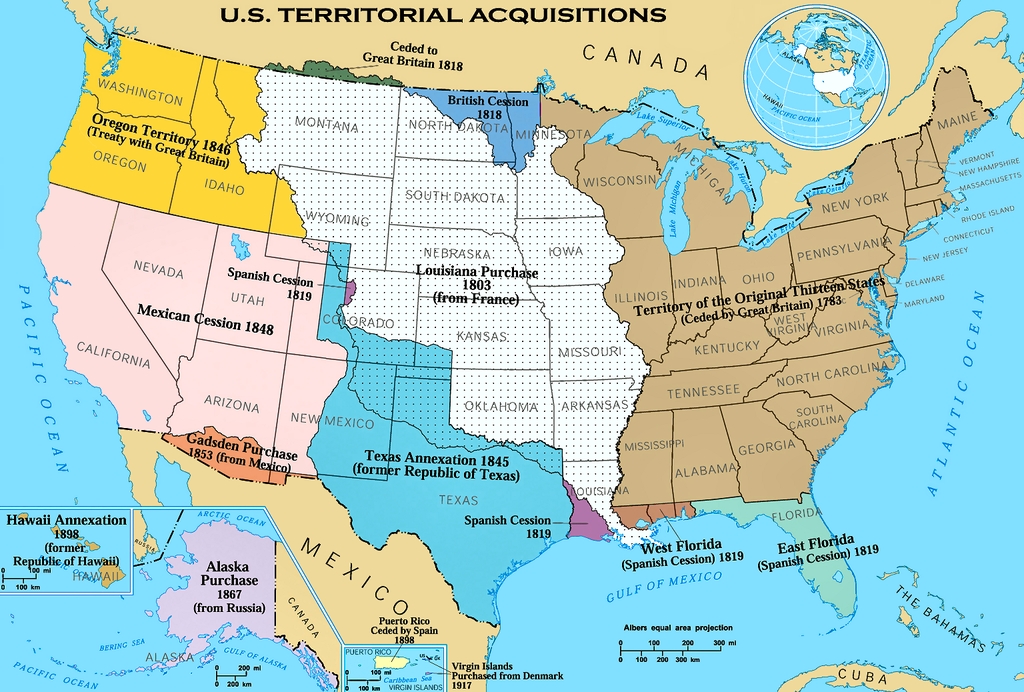|
The Gadsden Purchase History
Gadsden Purchase
The Gadsden Purchase Treaty was an agreement between the United States and Mexico, finalized in 1854, in which the United States agreed to pay
Mexico $10 million for a 29,670 square mile portion of Mexico that later became part of Arizona and New Mexico. Gadsden’s
Purchase provided the land necessary for a southern transcontinental railroad and attempted to resolve conflicts that lingered
after the Mexican-American War.
| The Gadsden Purchase Map |

|
| The Gadsden Purchase Map |
While the Treaty of Guadalupe Hidalgo formally ended the Mexican-American War in February 1848, tensions
between the Governments of Mexico and the United States continued to simmer over the next six years. The two countries each
claimed the Mesilla Valley as part of their own country. The Mexican Government demanded monetary compensation for Native
American attacks in the region because, under the Treaty, the United States had agreed to protect Mexico from such attacks;
however, the United States refused to comply, insisting that while they had agreed to protect Mexico from Native American
attacks, they had not agreed to financially compensate for attacks that did occur. The persistent efforts of private American
citizens to enter Mexico illegally and incite rebellions in an effort to gain territory exacerbated tensions between the governments.
These continuing tensions between Mexico and the United States complicated
U.S. efforts to find a southern route for a transcontinental railroad as the only viable routes passed through Mexican territory.
In 1847, the United States attempted to buy the Isthmus of Tehuantepec, an isthmus on the southern edge of North America,
as an alternative means of providing a southern connection between the Atlantic and
Pacific oceans. Mexico, however, had already granted Mexican Don José de Garay the right to build colonies for Americans on
the isthmus with capital from the New Orleans Company. Fearing the colonists would rebel (as those in Texas had rebelled),
Mexican President Juan Ceballos revoked the grant, angering U.S. investors.
In 1853, Mexican officials evicted Americans from their property in the disputed
Mesilla Valley. When the U.S. Government did not act, Governor William Lane of New Mexico declared the Mesilla Valley part
of the U.S. territory of New Mexico. Mexican President Antonio López de Santa Anna (aka Santa Anna) responded by sending troops into the valley. Attempting to diffuse the situation, U.S.
President Franklin Pierce sent James Gadsden, the new U.S. Minister to Mexico, to negotiate with Santa Anna. Secretary of
State William Marcy instructed Gadsden to renegotiate a border that provided a route for a southern railroad, arrange for
a release of U.S. financial obligations for Native American attacks, and settle the monetary claims between the countries
related to the Garay project.
Gadsden met with Santa Anna on September 25, 1853. President Pierce sent verbal
instructions for Gadsden through Christopher Ward, an agent for U.S. investors in the Garay project, giving Gadsden negotiating
options ranging from $50 million for lower California and a large portion of northern Mexico to $15 million for a smaller
land deal that would still provide for a southern railroad. Ward also lied to Gadsden, stating the President wanted the claims
of the Garay party addressed in any treaty concluded with the Mexican Government; however, President Pierce never gave Ward
these instructions because he did not believe in government involvement in affairs between private companies and foreign governments.
Santa Anna refused to sell a large portion of Mexico, but he needed money to fund an army to put down ongoing rebellions,
so on December 30, 1853, he and Gadsden signed a treaty stipulating that the United States would pay $15 million for 45,000
square miles south of the New Mexico territory and assume private American claims, including those related to the Garay deal.
The United States Government agreed to work toward preventing American raids along Mexico’s border and Mexico voided
U.S. responsibility for Native American attacks.
| Gadsden Purchase Map |

|
| Gadsden Purchase Map |
With a great deal of difficulty resulting from the increasing strife between
the northern and southern states, the U.S. Senate ratified a revised treaty on April 25, 1854. The new treaty reduced the
amount paid to Mexico to $10 million and the land purchased to 29,670 square miles, and removed any mention of Native American
attacks and private claims. President Pierce signed the treaty and Gadsden presented the new treaty to Santa Anna, who signed
it on June 8, 1854.
After Gadsden’s Purchase a new border dispute caused tension over the
United States’ payment, and the treaty failed to resolve the issues surrounding financial claims and border attacks.
However, it did create the southern border of the present-day United States, despite the beliefs of the vast majority of policymakers
at the time who thought the United States would eventually expand further into Mexico.
Source: U.S. State Department
Advance to:
Recommended Viewing: The History Channel Presents The Alamo
(DVD, 240 minutes) (See review and product description below)
Amazon.com
Remembering the Alamo won't be a problem after you've seen The Alamo, a richly informative, thematically
unified set of four History Channel documentaries. The centerpiece of this two-DVD set is "Remember the Alamo," hosted by
Dennis Quaid and produced to coincide with the April 2004 theatrical release of The Alamo, the historical epic (promoted
here in a behind-the-scenes featurette) in which Quaid plays Gen. Sam Houston. It's a typical History Channel production,
purporting to offer the definitive fair-and-balanced account of the siege on the infamous San
Antonio, Texas mission on the chilly morning of March 6, 1836, between
the Mexican centralist army of Gen. Santa Anna, and the "Texican" American rebels led by Davy Crockett, Jim Bowie, and William
Barret Travis. Numerous "talking head" scholars pore over new and established historical details, examining the political
and geographical circumstances that led to the massacre that left few survivors, and dispelling such myths as Crockett's fate
(he was captured and executed) and the number of Mexicans killed in the assault.
While some of the
latest research remains speculative, the context of the Alamo siege is thoroughly examined
in the other documentaries (previously issued on VHS) which fill out the set. Hosted by Kenny Rogers in Western regalia, two
segments of "The Real West" series go into more specific detail about the battle itself and the history--from ruthless frontier
justice to official law-enforcement status--of the legendary Texas Rangers. Most colorful of all, not surprisingly, is the
hour-long exploration of the larger-than-life exploits of Davy Crockett, a charming opportunist who nevertheless earned his
heroic status as a fearless leader who faced impossible odds at the Alamo siege. While some
of the expert testimony verges on shameless hero worship, it remains clear that the Alamo, and the events and personalities
that made history there, remains the most pivotal and politically complex turning point in the U.S. expansion of the westward frontier. --Jeff Shannon
Product
Description
Behind the most famous battle cry in American history is a story of ambition and heroism, greed and vanity,
desperation and defeat. THE HISTORY CHANNEL® PRESENTS: THE ALAMO examines the epic battle through four acclaimed programs
from THE HISTORY CHANNEL® and A&E, presenting a compelling picture of the forces, personalities and events that converged
at the San Antonio mission in 1836.
"Remember the Alamo" New research dispels some long-held beliefs about what really happened in the showdown between
Santa Anna's army and Davy Crockett, William Barret Travis, Jim Bowie, and their group of American volunteers.
"The Real
West: The Battle of the Alamo" Host Kenny Rogers focuses on
the strained collaboration among Davy Crockett, Jim Bowie, and William Barret Travis.
"The Real West: Texas Rangers" Ride
into the past to see how these legendary lawmen patrolled a vast and wild territory.
"BIOGRAPHY®: Davy Crockett: American
Frontier Legend" Experts explode the myths surrounding the backwoodsman who died at the Alamo.
The Gadsden Purchase Treaty Agreement History, Maps, Size of
the Gadsden Purchase, What States are included in the Gadsden Purchase, What is the Gadsden Purchase, Details, Facts, Year
Gadsden Purchase signed
|

